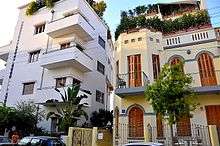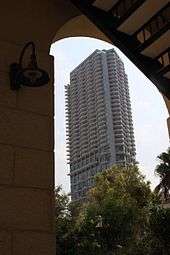Neve Tzedek
.jpg)
Neve Tzedek (Hebrew: נווה צדק, lit. Abode of Justice) is a neighborhood located in southwestern Tel Aviv, Israel. It was the first Jewish neighborhood to be built outside the old city of the ancient port of Jaffa. For years, the neighborhood prospered as Tel Aviv, the first modern Hebrew city, grew up around it. Years of neglect and disrepair followed, but since the early 1980s, Neve Tzedek has become one of Tel Aviv's latest fashionable and expensive districts, with a village-like atmosphere. Literally, Neve Tzedek means Abode of Justice, but it is also one of the names for God (Jeremiah 50:7).
History

Neve Tzedek was established in 1887, 22 years before the 1909 founding of the neighbourhood, later: city, of Tel Aviv, by a group of Jewish families seeking to move outside of over-crowded Jaffa. Soon, additional small developments grew up around Neve Tzedek and were incorporated into the contemporary boundaries of the neighbourhood.
The residents preferred to construct the new quarter with low-rise buildings along narrow streets. These homes frequently incorporated design elements from the Jugendstil/Art Nouveau and later Bauhaus art movements and featured contemporary luxuries such as private bathrooms.
At the beginning of the 1900s, some artists and writers made Neve Tzedek their residence. Most notably, future Nobel prize laureate Shmuel Yosef Agnon, as well as Hebrew artist Nachum Gutman, used Neve Tzedek as both a home and a sanctuary for art. Rabbi Abraham Isaac Kook was the first Rabbi of Neve Tzedek; he even maintained a Yeshiva there. During his time in Neve Tzedek he became very close friends with many of the writers, especially Agnon.
However, as Tel Aviv began to develop away from the Jaffa core, the more affluent people started to move out from the southern end of the city to inhabit the newly-developing northern areas. With its buildings abandoned, neglected and subjected to the unsightly corrosive effects of the shore atmosphere upon concrete and stucco, Neve Tzedek degenerated into disrepair and urban decay. As with the rest of South Tel Aviv, after 1948, it became a predominantly Mizrahi area. By the 1960s, city officials deemed the neighbourhood – by this time almost a slum – incompatible with the modern image of a busy, bustling city. However, plans to demolish the historic neighbourhood to make way for high rise apartments were eventually cancelled as many Neve Tzedek buildings were placed on preservation lists. At the same time, the old, worn-out neighbourhood was also becoming appreciated as an oasis of the semi-pastoral and picturesque amidst the modernist development of the city center.
By the end of the 1980s, efforts began to renovate and preserve Neve Tzedek's century-old structures. New establishments were housed in old buildings, most notably the Suzanne Dellal Centre for Dance and Theatre and the Nachum Gutman Museum, located in the artist's home. This gentrification led to Neve Tzedek's rebirth as a fashionable and popular upmarket residence for Tel Avivians. Its main streets became lined once again with artists' studios, including the ceramics studio of Samy D., alongside trendy cafés and bars, and more recently boutique hotels and shops selling hand-made goods to wealthy Israelis and tourists.
The Tel Aviv Light Rail, which is expected to pass near Neve Tzedek, will make the neighbourhood even more accessible for visitors and residents alike.
Education
The Collège Français Marc Chagall de Tel-Aviv (Hebrew: בית הספר הצרפתי מארק שאגאל תל אביב), a French international school, is in Neve Tzedek.[1]
Controversial plans

In 2009, the Tel Aviv municipality began to approve plans to construct a number of new highways and widened arterial roads throughout southern Tel Aviv, including the proposed railway road, which would partially encircle Neve Tzedek. As part of these plans, the municipality approved the construction of a large number of skyscrapers in and around Neve Tzedek. A number of parking lots would also be constructed along Rothschild Boulevard in order to handle the parking demand induced by the new road space.[2]
Opponents of this plan cited a number of concerns with the approval process and with the plan itself. First and foremost, they argue that the addition of new skyscraper-lined highways will dramatically alter the historical and social character of Neve Tzedek and its surrounding areas in southern Tel Aviv. Furthermore, many residents and environmentalists are concerned about the effects of large amounts of traffic being funneled through the area, especially in a time when other developed cities are removing highways, which are now seen as mistakes from the past.[2]
Beyond the concerns with the project itself, opponents believe that the discussions have been conducted outside of the public view and with developers' interests being put before those of the community.[2]
Notable residents
- Roman Abramovich (born 1966), Chelsea FC owner, businessman, investor, and politician
- Shmuel Yosef Agnon (1888–1970), modern Hebrew writer, Nobel Prize laureate for literature
- Baruch Agadati (1895–1976), classical ballet dancer, choreographer, painter, and film producer and director
- Yosef Haim Brenner (1881–1921), pioneer of modern Hebrew literature
- Aharon Chelouche (born 1827), Algerian Jewish businessman, co-founder of the neighborhood
- Yosef Eliyahu Chelouche (1870–1934), son of Aharon, one of the founders of Tel Aviv, entrepreneur, businessman and industrialist
- Gal Gadot (born 1985), actress and model
- Miriam Glazer-Ta'asa (born 1929), politician
- Nachum Gutman (1898-1980), painter, sculptor, and children's books author[3]
- Yoram Kaniuk (1930–2013), writer, painter, journalist, and theater critic
- Sara Levi-Tanai (1910–2005), choreographer and songwriter
- Israel Rokach (1886–1959), politician, second mayor of Tel Aviv (1936-1953), son of Shimon Rokach, one of the founders of the neighborhood
See also
References
- ↑ "Contacts." Collège Français Marc Chagall de Tel-Aviv. Retrieved on 22 January 2015. "Sur Place ou Par Courrier : 24 Rehov Chelouch ( ou Shlush), Neve Tzedek Tel-Aviv, Israël"
- 1 2 3 http://greenprophet.com/2009/07/21/10783/skyscraper-city/ "Citizens Shut Out as Tel Aviv Debates Skyscraper City" Green Prophet. 21 July 2009. Accessed 18 August 2009.
- ↑ http://www.gemsinisrael.com/e_article000048636.htm
External links
Coordinates: 32°3′40.55″N 34°45′56.13″E / 32.0612639°N 34.7655917°E
